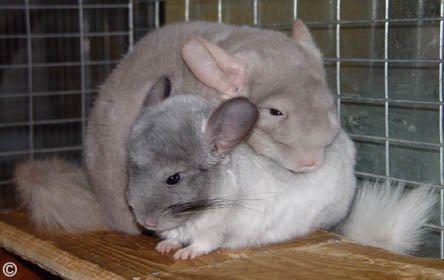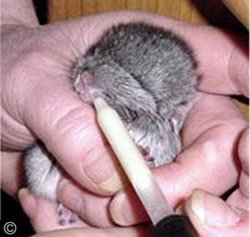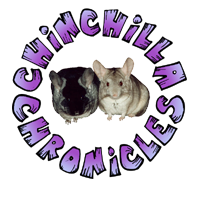 Chinchilla weaning should only be started when a kit (baby) is 8+ weeks old (preferably 12 weeks) and at least 200 grams in weight!
Chinchilla weaning should only be started when a kit (baby) is 8+ weeks old (preferably 12 weeks) and at least 200 grams in weight!
Weaning a chinchilla kit sooner than it is of good weight or the correct age will cause behavior problems, digestive disorders and health problems later in life.
Weaning from the chin mum's milk is usually decided between the mum and kit themselves but if the process hasn't started at 8 weeks you will need to help weaning process along for the final 4 weeks.
If weaning from the maternal cage is not done before siblings reach sexual maturity sever fighting and in-breeding will occur, which is highly discouraged for obvious reasons.
Chinchillas have no conception of being related to one another therefore, it is important that you prevent any chances of in-breeding to occur and wean siblings from the maternal cage by 12 weeks old at the latest!
When 'weaning' time comes, it is best to place the kits of the same sex into a communal cage rather than on their own and still within vocal range of their parents. This helps develop the kit's social behavior and eases any stress of leaving their chin-parents. By separating the male and female kits you also prevent the chances of in-breeding within siblings, which can prove fatal.
Sexing Chinchillas

 Some owners and even pet shops can mis-sex chinchillas, this is because the female exposes a urethral canal, which looks like the male's penis. The easiest way to sex chinchillas is to look at the genital area and examine the space (perineum) between the visible cone and the anus. If there is a space between the cone and the anus then you are looking at a male. If there is no space between the cone and the anus then you are looking at a female. There is also a noticeable line on the underside of the female's urethral cone that extends towards the anus.
Some owners and even pet shops can mis-sex chinchillas, this is because the female exposes a urethral canal, which looks like the male's penis. The easiest way to sex chinchillas is to look at the genital area and examine the space (perineum) between the visible cone and the anus. If there is a space between the cone and the anus then you are looking at a male. If there is no space between the cone and the anus then you are looking at a female. There is also a noticeable line on the underside of the female's urethral cone that extends towards the anus.
It is important to regularly weigh chinchillas and that means from birth. A newborn chinchilla kit weighs on average 35-60 grams and increases at a rate of approximately 5-10 grams per week. It is imperative that you regularly weigh any weaning chinchillas whether it is from the chin-mum's milk or hand-feeding to ensure there is a continual 'healthy' weight gain.
Any chinchilla that exposes weight loss during the weaning process is too young, not ready to be weaned or has an underlying health issue, which will need urgent attention and the process of weaning must be reversed until a healthy sustainable weight gain is noted.
The chin-mum will still have a continual milk supply during the early stages of weaning and the chinchilla kits can return once or twice a day to feed, slowly reducing the visiting times over the upcoming days. By 2 weeks a chinchilla kit should be fully weaned from its mothers milk.
Chinchilla kits can over eat, which is a major contributory factor to juvenile mortality and it is therefore important to not over-compensate. At the age of 8 weeks a kit should be consuming approximately ½ - ¾ tablespoons of chinchilla pellets, a small handful of good quality coarse hay and distilled water daily.
Until a chinchilla is 6 months old they should be consuming no more than 1 tablespoon of chinchilla pellets per day, after which, the portion size can increase to 2 tablespoons per day.
Never offer a chinchilla kit treats under 4 months old and only ¼ tablespoon of 'safe' treats thereafter.
Digestive problems are common in kits especially during times of weaning due to sudden changes in food substances. It is imperative weaning is done slowly and solid foods are introduced gradually!
Hand Rearing a Chinchilla Kit
A chinchilla kit that is not feeding itself is in need of urgent 'dedicated' attention if it is to survive!
A chinchilla kit must be manually fed every 1-2 hours around-the-clock during the initial weeks and will also need to be stimulated to pass faeces and urine by 'topping and tailing' using damp cotton wool. It is also essential to keep a check on the kit's weight growth and tooth enamel colour to ensure they are dark orange - as anything less than this (light orange / yellow / white) will indicate a calcium deficiency that will need urgently correcting.
The majority of the time chinchilla kits will not need hand rearing but occasionally a situation may occur where the chin-mum has rejected her kit at birth, the litter is too large and there is not enough milk (or no milk at all - Agalactia) to go around, the chin-mum may have sadly passed away or a smaller, weaker kit is  being bullied by siblings.
being bullied by siblings.
Below is a tested milk formula you can offer a chinchilla kit...
Chinchilla Milk Formula Feed
- 1 part evaporated milk
- 2 parts cooled boiled water
- 1 tiny pinch of probiotic such as Avipro Plus
- 1 tiny pinch of Critical Care powder
- 1 tiny pinch of Nutrobal (calcium and mineral supplement)
The above milk formula can be liquefied and presented via a syringe using the Hand-Feeding Method suggested. The formula must be at a temperature of 99°-100°F and only reheated once.
Very young chinchilla babies that are depending entirely upon hand feeding for their nourishment, must be fed every 2-3 hours, giving them one-half of a syringe of formula and upwards depending on their age. With older kits the feeding can be spaced several hours apart and 4 feedings daily.
When a chinchilla kit has had all of the food it wants it will appear to resist being offered any more by pushing the syringe away with the forepaw. Stop feeding at this stage as over-filling a kit's stomach can not only lead to digestive problems such as bloat but also cause juvenile mortality!
Formula can be made up and stored in a refrigerator for 24 hours before a fresh supply must be made. Take out the amount of formula you need and warm only once to room temperature.
Remember: Chinchilla kits must be fed every 2 hours around the clock if there is to be any chance of survival. To help feeding a chinchilla kit you can try them on the water bottle as they can take very quickly to this method when shown how.
Offering bottles instead of hand feeding has added benefits as it will save you around the clock feeding and allows the kit to take its milk directly from the bottle as and when it wants instead of waiting to be fed.
Introducing A Chinchilla Kit To A Bottle...
Introducing a chinchilla kit to a bottle is relatively easy and once tasted a kit will generally prefer a bottle to being hand fed.
Start by warming the formula to room temperature before gently picking the kit up. Carefully rub the spout end of the bottle along the chinchilla's lower lip until they get the taste of the milk and take a lick.
A small milk droplet leaking from drinking spout can encourage a kit to take a tentative sip on its own accord. When this happens hold the bottle upright and present to the kit. Ensure no fluid goes up the chinchilla's nose (as this can lead to strangulation and/or Inhalation Pneumonia) and ensure they are sipping from a bottle confidently.
Insert the bottle, low enough for the kit to reach, to the inside of the chinchilla cage and place the kit in front of it. Once a chinchilla kit knows what the bottle is for, they will generally be happy to feed themselves.
WARNING - Always regularly check the milk bottle to ensure the milk is free flowing BEFORE offering it to a chinchilla. Warm milk formula generally makes the air inside the bottle expand preventing milk to escape then exploding from the nozzle when squeezed. Gently squeeze the bottle away from yourself and the chinchilla and expel the trapped air inside before positioning it within the cage.
If you choose the bottle method to feed a chinchilla kit you must still check the kit is feeding during the night, monitor the daily consumption and you must sterilize the bottle, especially the nozzle, after every use to avoid lethal bacteria build up.
Further Reading Relating To Hand Rearing A Chinchilla Kit:
Birthing Complications, Chinchilla Care, Hand Feeding A Chinchilla, Health, Minerals And The Relation To Chinchilla Disease, Nutrition (Food & Diet), Vitamins And The Relation To Chinchilla Disease.


 Chinchilla weaning should only be started when a kit (baby) is 8+ weeks old (preferably 12 weeks) and at least 200 grams in weight!
Chinchilla weaning should only be started when a kit (baby) is 8+ weeks old (preferably 12 weeks) and at least 200 grams in weight!
 Some owners and even pet shops can mis-sex chinchillas, this is because the female exposes a urethral canal, which looks like the male's penis. The easiest way to sex chinchillas is to look at the genital area and examine the space (perineum) between the visible cone and the anus. If there is a space between the cone and the anus then you are looking at a male. If there is no space between the cone and the anus then you are looking at a female. There is also a noticeable line on the underside of the female's urethral cone that extends towards the anus.
Some owners and even pet shops can mis-sex chinchillas, this is because the female exposes a urethral canal, which looks like the male's penis. The easiest way to sex chinchillas is to look at the genital area and examine the space (perineum) between the visible cone and the anus. If there is a space between the cone and the anus then you are looking at a male. If there is no space between the cone and the anus then you are looking at a female. There is also a noticeable line on the underside of the female's urethral cone that extends towards the anus. being bullied by siblings.
being bullied by siblings.